.
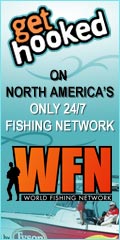
Click Here
|
Live-Bait and
Hook-Selection Primer
By Justin Hoffman
Since the
inception of angling, live bait has been a hands-down winner. No
matter what lure or fly you tie on your line, duplicating nature is
a formidable task. Although an artificial lure might resemble and
even act like the true prey of fish, the texture, taste, and
movement of real food
can seldom be beat.
We've been
bombarded with knowledge of the live baits that are available. We
know night crawlers, minnows, crayfish, frogs, and leeches are the
most widely used. But, with many anglers now using artificials for
most of their fishing, when the chips are down and the real deal
seems the way to go, knowing the appropriate bait, hook, and rigging
to choose, depending on the fish species being targeted, is a must.
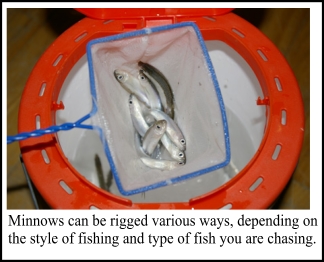
Largemouth Bass
Bucketmouths have healthy appetites and readily accept many types of
offerings that swim by or are tossed their way. Top choices include
minnows, frogs, crayfish, and whole night crawlers. Due to the
largemouth's yap,
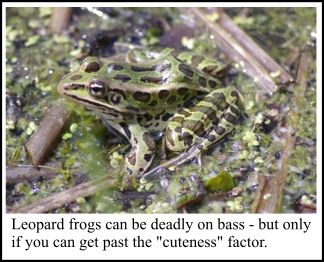 relying
on above-average-size bait is recommended for lunkers. Frogs work
wonders in shallow areas, especially when worked on the surface,
whereas crayfish excel when fished slowly over rocky points and
breaklines. Three to six-inch minnows excel in most situations. relying
on above-average-size bait is recommended for lunkers. Frogs work
wonders in shallow areas, especially when worked on the surface,
whereas crayfish excel when fished slowly over rocky points and
breaklines. Three to six-inch minnows excel in most situations.
Smallmouth Bass
Crayfish, especially those that are four to five-inches, reign
supreme for bronzebacks, with minnows and leeches following closely
behind. Lively craws, especially soft shells, worked across rocky
shoals and sandbars drive these fish crazy. When using leeches,
choose the biggest you can get your hands on. Three or four-inch
minnows are standard for smallmouth, but increase the size used as
the season progresses and prey size increases. Keep in mind leeches
are usually a poor bet when water temperature drops below 50s F., as
they ball up on the hook, refusing to uncoil and swim naturally.
Bluegill and Sunfish
These small-mouthed pannies are the heroes of childhood fishing
memories. A small portion of worm is the easiest and most convenient
bait to throw their way, resulting in many hookups and fast action.
Other tidbits such as maggots and waxworms also get the nod from
serious bluegill anglers, especially in winter.
Catfish Family
When chasing after bullhead and channel cats, a big mass of worm
balled on a hook routinely gets the nod. Sitting on or just above
bottom will be your best bet. Although live minnows will take
fish, the reliance on dead stink baits will up your odds. Lifeless
chub, sucker or sardine will always arouse the attention of a cat,
as will any of the various farm-animal livers found on your grocers
shelf. The more stink to the bait, the better the results.
Crappie
One-and-half to two-inch minnows are tops for these oversized
panfish, especially in cold water. Small portions of worms also work
as the water warms. Despite the crappie's relatively large mouth,
keep baits small, although you can increase size in warmer weather
to catch lunkers.
Yellow Perch
Much like crappie, perch are suckers for small minnows, but worms
and small crayfish also turn their crank. Minnows, especially
pinhead emerald shiners, are standards among perch anglers from fall
through spring, with worms getting the nod once the water warms.
Leeches will also produce perch, but can be expensive to use when
the bite is on. While pinhead minnows are the norm to use for perch,
adjust the size of the bait to the perch you hope to catch. In areas
harbouring jumbos over 12 inches, even a 3-inch minnow isn't too
large.
Pike and Muskie
Large minnows get the nod when chasing pike or muskie, with live and
dead varieties both working well. Oversized chubs, suckers or smelt,
ranging between five and ten-inches long are the norm, and can be
suspended under a float or drift fished near bottom. Big, robust
leopard frogs also make an ideal bait for pike or muskie, and can
definitely get the heart pounding when fished on the surface.
Live bait
seems to work best during the warm summer months, with dead bait
shining early and late in the season. These predators are at the top
of the food chain, so don't be shy when tossing them an offering to
chow down on.
Walleye
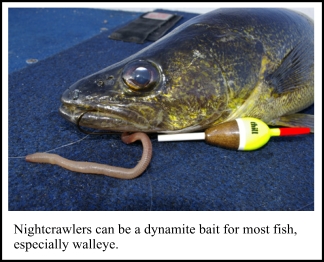 Minnows,
leeches, and night crawlers are all capable of catching finicky
walleye, although each seems best at certain times of the year.
While night crawlers produce throughout the open-water season,
minnows are best at the start and tail end of it. Leeches and night
crawlers are go-to summer baits. Minnows in the 3- to 4-inch range
work for most walleye applications, but as fall approaches and
golden lunkers start pack on the feedbag before winter hits, use
baitfish as large as 6 inches. Shiners, suckers, and chub lead the
preyfish pack for walleye. Minnows,
leeches, and night crawlers are all capable of catching finicky
walleye, although each seems best at certain times of the year.
While night crawlers produce throughout the open-water season,
minnows are best at the start and tail end of it. Leeches and night
crawlers are go-to summer baits. Minnows in the 3- to 4-inch range
work for most walleye applications, but as fall approaches and
golden lunkers start pack on the feedbag before winter hits, use
baitfish as large as 6 inches. Shiners, suckers, and chub lead the
preyfish pack for walleye.
Hooks to Look For
The live-bait angler can get by with a few tried-and-true choices
that cover the spectrum of rigging options. Since packaging and
catalogue terminology is inconsistent, here are hooks with their
common names. The Aberdeen hook is noteworthy for its elongated
shank and wide gap. Mostly
used with worms, minnows, and larva baits, the Aberdeen allows for
easy removal from a fish, as the shank is always visible for easy
access. This hook is popular for small-mouthed panfish. If you're
introducing a child to angling, an Aberdeen is a perfect hook to
start with. The long shank will help kids get a safer feel for
unhooking fish and baiting up will be easier than if using
short-shank hooks.
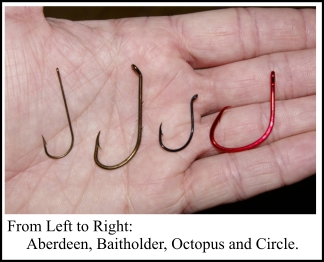
Bait-holder
hooks are recognizable by a series of two or more barbs on the
shank. They're standards with many anglers who fish with night
crawlers, to help hold them on the shank. This improves bait
longevity and limits nibbling from small fry that commonly occurs
when fishing crawlers. Don't get me wrong, even big fish will
nibble, but they don't have to always steal
your bait.
Octopus-style
bait hooks are popular with walleye and bass anglers, and might well
be the freshwater industry standard for everything from minnows and
leeches to roe bags. They have a wide gap and a short shank that can
accommodate a range of baits. The round shape of the Octopus also
offers good hook-sets and, because most are made with thin material,
they minimize
damage to bait. Styles with turned-up eyes also allow for easy
snelling, which many walleye anglers rely on for bottom-bouncing and
harness rigs. Circle hooks, first used by commercial tuna catchers,
are making inroads with freshwater live-bait anglers. For those who
catch and release most of their fish, the circle hook seems the way
to go. Similar in appearance to the octopus style, the circle hook
has a round bend in the gap, ending with a hook point that swings in
towards the shank. At first glance, most people wonder how the angle
of the point could ever hook a fish, but herein lies the secret.
Unlike most fishing hooks, where it takes the force of a hook-set to
stick a fish, circle hooks work on a different principal. When a
fish inhales a bait and begins to swim away, the line will become
taut. This allows the hook to be pulled from inside the fish's
throat and to the corner of the mouth. Don't set the hook. When you
apply pressure with the rod and line tension continues to increase,
the hook rotates and pierces the cartilage of the fish's lip. Due to
the style of the hook, once a fish is pegged, it rarely comes
unhooked. As gut-hooking is greatly reduced, though, unhooking and
releasing fish are easier, and mortality rates are lower.
Bait-Hooking
Strategies
When it comes to night crawlers, the relationship between bait and
hook comes down to the targeted species. For panfish, threading the
worm or portions of one along the shank of the hook, or impaling it
two or three times, is preferred. Leave the ends dangling slightly
for added action. Since these fish have small mouths, a 1- to 2-inch
piece of worm works best. If you're dealing continuously with
nibblers, your presentation is too large. For bigger prey,
such as bass and walleye, hook the worm once through the collar,
directly through the middle (wacky-worm style), or through the fat
end, depending on how you're fishing it. Up-front hooking is best
for fishing a worm on a moving presentation, such as a trolled
harness or a drifting rig. Larger fish will inhale a whole night
crawler, so don't worry that excess worm is away from the hook, as
this adds to a realistic presentation.
Hooking a
leech once through the larger suction cup allows it to swim in an
enticing manner. When a fish strikes, a leech often rolls up in a
ball, wrapping around the hook and making a hook-set difficult. When
using larger leeches, a bigger hook can help to combat this
predicament. There are many hooking approaches with minnows. Two
popular methods are hooking them upwards through both lips or by
impaling the hook just below the dorsal fin, being careful not to
nick the spine and kill the bait. Back hooking allows the minnow
freedom to move and, if done correctly, it will last longer. Back
hooking is best suited to still-fishing with a float, whereas
lip-hooked minnows work best for trolling or rigging.
When chasing
pike or muskie, a quick-strike rig gets the nod, especially when
using oversized suckers or chubs. You can buy these rigs, but
they're easy to make. For rigging, pierce a single hook up through
the snout of the bait, with a wire-leader-rigged treble hooked
lightly through the back or side section of the baitfish.
Whether free-lining or rigging, hooking a crayfish upwards through
the tail section is standard. Depending on the size of the crayfish,
a half or a full inch from the end of the tail is sufficient. This
allows the bait to move naturally. If float fishing is more your
style, hooking through the top of the shell is better.
Depending on
the amount of vegetation or structure, removing the claws will
prevent crayfish from grabbing onto debris and escaping the hook.
Another trick is to remove only one claw, giving the crustacean the
appearance of an injured and accessible meal.
Although less
popular today, frogs can be a great bait for bass, walleye, pike,
and muskie. For those who can get past the cuteness factor, frogs
can be tremendous baits. Hook the amphibian through both lips,
coming up from the bottom, which allows the frog to swim in a
natural manner. Live bait will always be effective for catching
fish. By using the right bait and hook for your targeted specie,
your success rate at catching fish will increase. And let's face it,
that's what every angler strives for when plying their favourite
honey holes.
|